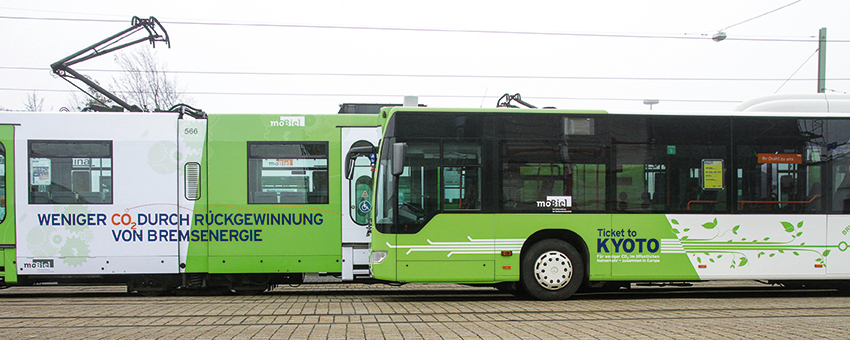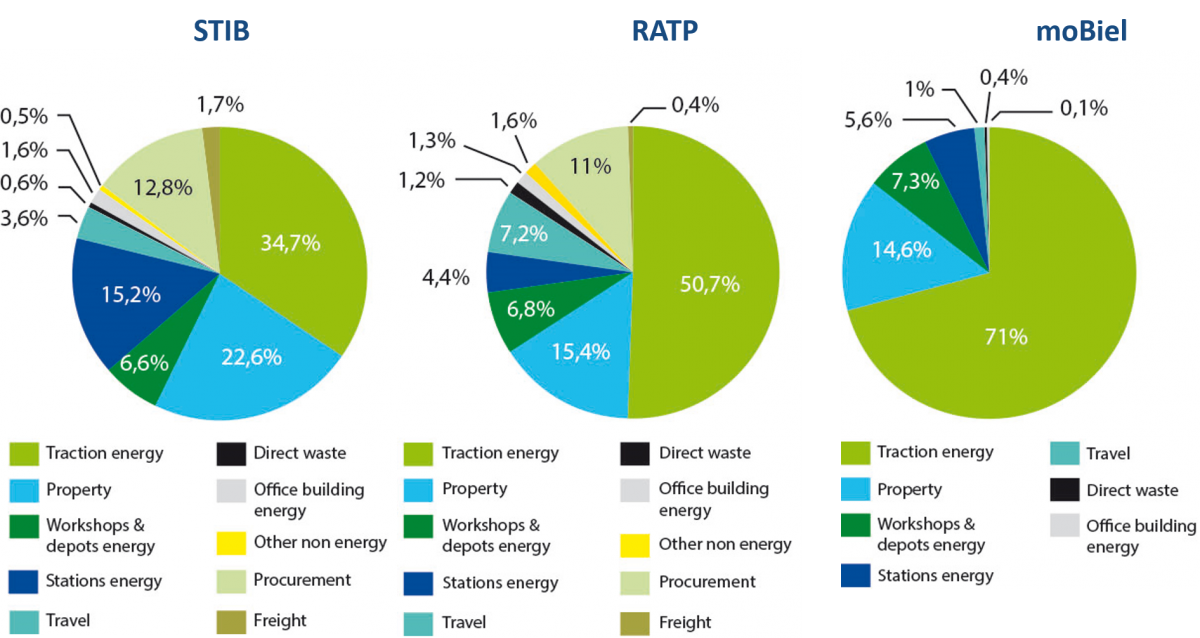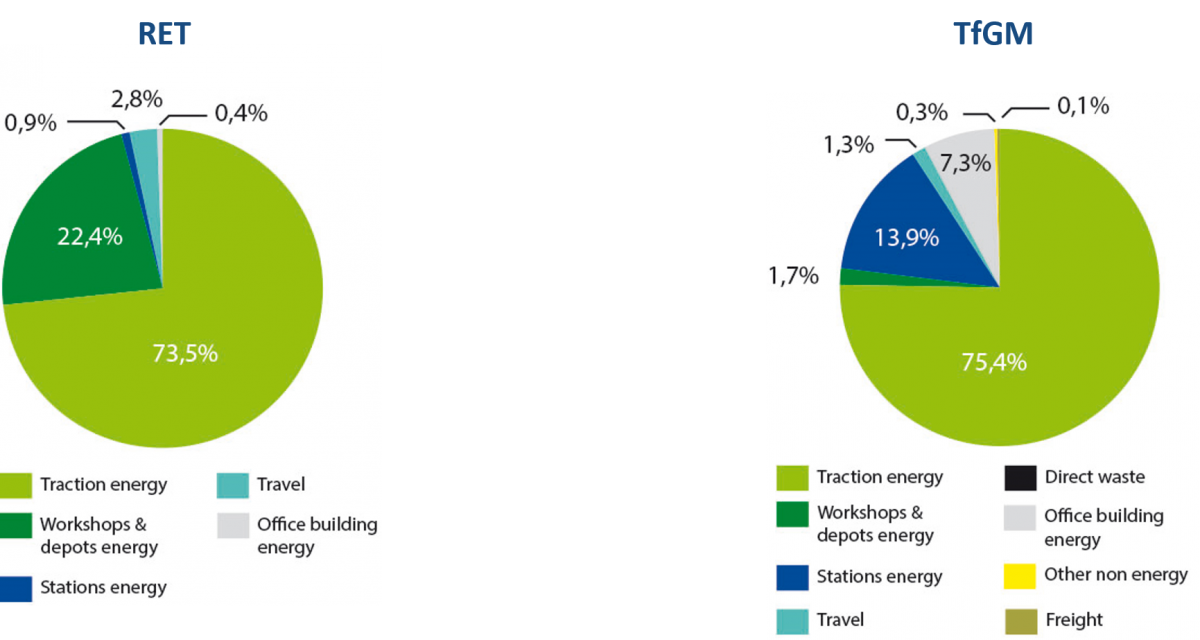When defining a carbon reduction strategy, it is important to calculate the carbon footprint of all the activities of the transport company. This will help to change the current situation by increasing the importance attached to GHG reduction efforts in the company’s main strategy. Today, there is a wide range of different methods for calculating a carbon footprint. One goal of Ticket to Kyoto was to define common and comparable methods for carbon footprint and indicators adapted to the public transport sector, so that it becomes possible to monitor the efforts of each individual company and to benchmark them.
Methodologies
Bilan Carbone ®
The aim of the Bilan Carbone method is to measure carbon emissions, in order to get an accurate evaluation of the emissions resulting from an activity or territory. The method enables users to evaluate GHG emissions generated by all the physical processes that are necessary for the existence of an organisation. The Bilan Carbone method was developed in 2004 by ADEME, the French Environment and Energy Management Agency. The Bilan Carbone approach involves the construction of a project for evaluating and reducing GHG emissions. It consists of six key steps:
- Develop awareness of the greenhouse effect
- Define the scope of study
- Gather data
- Process and analyse the results
- Establish a plan of action for reductions
- Implement the plan.
The Bilan Carbone accounting tool is a software comprising an Excel file in which all data are consolidated to provide the final results. It is readable and flexible, and allows the prioritisation of emissions by size. This prioritisation is an essential stage for the construction of reduction action plans.
One of the fundamental parts of the method involves putting on an equal footing the GHG emissions that are generated directly within the entity and the emissions that are external from the entity but that are the counterpart of processes necessary to its existence.
GHG Protocol
As with the Bilan Carbone, the Greenhouse Gas Protocol aims to count GHG emissions related to an activity. The GHG Protocol provides standards and guidance for companies and other organisations preparing a GHG emissions inventory. It covers the accounting and reporting of the six greenhouse gases6 covered by the Kyoto Protocol. It was designed with the following objectives in mind:
- To help companies prepare a GHG inventory that represents a true and fair account of their emissions, through the use of standardised approaches and principles
- To simplify and reduce the costs of compiling a GHG inventory
- To provide business with information that can be used to build an effective strategy to manage and reduce GHG emissions
- To increase consistency and transparency in GHG accounting and reporting among various companiesand GHG programmes.
The method was developed by the World Resources Institute (WRI) and the World Business Council for Sustainable Development (WBCSD), two non-profit organisations specialised in research and political analysis on questions related to resources management.

The GHG Protocol is also based on Excel sheets and guidance documentation. There are two modules: a methodology for counting the emissions from a company and a methodology for calculating the reductions of emissions.
The GHG Protocol defines direct and indirect emissions as follows:
- Direct GHG emissions are emissions from sources that are owned or controlled by the reporting entity
- Indirect GHG emissions are emissions that are a consequence of the activities of the reporting entity, but occur at sources owned or controlled by another entity.
Definition of a scope
The first step of a carbon footprint is to define the activities of the company that have to be included in the carbon analysis (network, sub-contractors, buildings, etc.). The broader the scope of the assessment, the easier it will be to highlight all the sources where it is possible to act in order to reduce the overall effect on climate change. However, broad scopes often increase uncertainties and resources required (mostly staff time) due to the difficulty of evaluating precisely more distant emissions.
Data collection
The second step is to collect data corresponding to the physical flows that concern the entity (energy, people, objects, raw materials, etc.). A company can provide a lot of different data: energy use, buildings or traction energy consumption, and number of passengers or kilometres travelled. This data must be sorted and the most relevant information has to be highlighted.
Analysis of results
The third step is to analyse the results obtained. All emissions are stated as a carbon dioxide equivalent and can be entered directly into the account or estimated. For an estimation, the quantity of greenhouse gas emitted is obtained by multiplying an activity figure by the corresponding emission factor. A comprehensive carbon footprint should ideally be carried out every three to five years to assess changes in the GHG emissions within the company. Performance indicators (see below) will allow the company to keep an eye on the evolution of the main drivers on an annual basis.
T2K approach to carbon footprinting
Ticket to Kyoto partners wanted to find a methodology that would be useful for all public transport companies – whatever their size, language or local regulation. The chosen tool had to be the best compromise for the following criteria:- Reduction-oriented
- Open and free solution
- European dissemination
- Fast implementation
The Bilan Carbone method and the GHG Protocol were already used respectively by RATP and TfGM. Both methods are reduction-oriented solutions and their documentation is free7.
The GHG Protocol is a worldwide reference, whereas Bilan Carbone remains more local despite its translation into English. The main difference between the two solutions lies in the complexity of implementation by new users. The software of each is built on Excel sheets. However, the GHG Protocol is made up of several sheets that are not compiled, while the Bilan Carbone comprises a single file. The Ticket to Kyoto partners decided to use the Bilan Carbone methodology due to its simpler format and ease of implementation.
The Bilan Carbone method is divided into sections related to energy, refrigerant fluids, materials and services, packaging, freight, waste, transport of persons, use of products, end of life of products, and the depreciation of fixed assets. To take into account the specificities of the public transport sector, the tool has been slightly adapted. Some sections not relevant to public transport were removed, especially for packaging and manufacturing. The energy section was also modified to better reflect the transport activities and enable partners to benchmark and compare the carbon performance of different transport modes and infrastructure by adding four new relevant subsections:
- traction energy consumption
- station energy consumption
- workshops and depots energy consumption
- office building energy consumption.
This modification gives energy a more prominent place in the accounting tool, in line with its importance for transport operators. On the basis of this adapted method, T2K partners together defined the items that were important for public transport and on which they could act in order to reduce the total amount of emissions of the transport companies.
Each partner chose a specific scope for the global assessment of its CO emissions. The specific perimeter had to include at least a common minimum scope defined jointly (compulsory emissions). This was done by all partners, except for some items due to a lack of available data. Optional items could be added on a voluntary basis (e.g. construction emissions).
Compulsory items
- Traction energy
- Stations energy
- Workshops and depots energy
- Office building energy
- Other emissions not related to energy
- (refrigerant fluids)
- Internal freight
- Business travel
Optional items
- Inputs (procurement of goods and services)
- Incoming freight
- Staff commuting8
- Direct waste
- Depreciation of property.
The figure below presents the carbon emissions in tons of CO equivalent per item for each partner. It is worth pointing out that energy consumption is the first emissions source, whatever the scope of the carbon balance and the size of the company.

7 Since 2011, the 7 th version of the Bilan Carbone has come with a licence.
8 Commuting is worth assessing by transport operators because most employees are drivers or technical staff, starting or finishing their working day out of opening hours. The introduction of incentives and special services to avoid them coming to work by car can really help to reduce the emissions due to home-work travel. Although care should be taken to avoid double counting emissions already included in wider public transport emissions.
